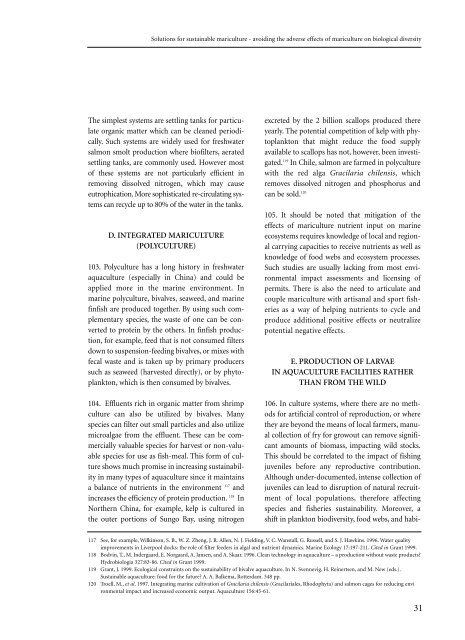Solutions for sustainable mariculture - Convention on Biological ...
Solutions for sustainable mariculture - Convention on Biological ...
Solutions for sustainable mariculture - Convention on Biological ...
- No tags were found...
Create successful ePaper yourself
Turn your PDF publications into a flip-book with our unique Google optimized e-Paper software.
<str<strong>on</strong>g>Soluti<strong>on</strong>s</str<strong>on</strong>g> <str<strong>on</strong>g>for</str<strong>on</strong>g> <str<strong>on</strong>g>sustainable</str<strong>on</strong>g> <str<strong>on</strong>g>mariculture</str<strong>on</strong>g> - avoiding the adverse effects of <str<strong>on</strong>g>mariculture</str<strong>on</strong>g> <strong>on</strong> biological diversityThe simplest systems are settling tanks <str<strong>on</strong>g>for</str<strong>on</strong>g> particulateorganic matter which can be cleaned periodically.Such systems are widely used <str<strong>on</strong>g>for</str<strong>on</strong>g> freshwatersalm<strong>on</strong> smolt producti<strong>on</strong> where biofilters, aeratedsettling tanks, are comm<strong>on</strong>ly used. However mostof these systems are not particularly efficient inremoving dissolved nitrogen, which may causeeutrophicati<strong>on</strong>. More sophisticated re-circulating systemscan recycle up to 80% of the water in the tanks.D. INTEGRATED MARICULTURE(POLYCULTURE)103. Polyculture has a l<strong>on</strong>g history in freshwateraquaculture (especially in China) and could beapplied more in the marine envir<strong>on</strong>ment. Inmarine polyculture, bivalves, seaweed, and marinefinfish are produced together. By using such complementaryspecies, the waste of <strong>on</strong>e can be c<strong>on</strong>vertedto protein by the others. In finfish producti<strong>on</strong>,<str<strong>on</strong>g>for</str<strong>on</strong>g> example, feed that is not c<strong>on</strong>sumed filtersdown to suspensi<strong>on</strong>-feeding bivalves, or mixes withfecal waste and is taken up by primary producerssuch as seaweed (harvested directly), or by phytoplankt<strong>on</strong>,which is then c<strong>on</strong>sumed by bivalves.104. Effluents rich in organic matter from shrimpculture can also be utilized by bivalves. Manyspecies can filter out small particles and also utilizemicroalgae from the effluent. These can be commerciallyvaluable species <str<strong>on</strong>g>for</str<strong>on</strong>g> harvest or n<strong>on</strong>-valuablespecies <str<strong>on</strong>g>for</str<strong>on</strong>g> use as fish-meal. This <str<strong>on</strong>g>for</str<strong>on</strong>g>m of cultureshows much promise in increasing sustainabilityin many types of aquaculture since it maintainsa balance of nutrients in the envir<strong>on</strong>ment 117 andincreases the efficiency of protein producti<strong>on</strong>. 118 InNorthern China, <str<strong>on</strong>g>for</str<strong>on</strong>g> example, kelp is cultured inthe outer porti<strong>on</strong>s of Sungo Bay, using nitrogenexcreted by the 2 billi<strong>on</strong> scallops produced thereyearly. The potential competiti<strong>on</strong> of kelp with phytoplankt<strong>on</strong>that might reduce the food supplyavailable to scallops has not, however, been investigated.119 In Chile, salm<strong>on</strong> are farmed in polyculturewith the red alga Gracilaria chilensis, whichremoves dissolved nitrogen and phosphorus andcan be sold. 120105. It should be noted that mitigati<strong>on</strong> of theeffects of <str<strong>on</strong>g>mariculture</str<strong>on</strong>g> nutrient input <strong>on</strong> marineecosystems requires knowledge of local and regi<strong>on</strong>alcarrying capacities to receive nutrients as well asknowledge of food webs and ecosystem processes.Such studies are usually lacking from most envir<strong>on</strong>mentalimpact assessments and licensing ofpermits. There is also the need to articulate andcouple <str<strong>on</strong>g>mariculture</str<strong>on</strong>g> with artisanal and sport fisheriesas a way of helping nutrients to cycle andproduce additi<strong>on</strong>al positive effects or neutralizepotential negative effects.E. PRODUCTION OF LARVAEIN AQUACULTURE FACILITIES RATHERTHAN FROM THE WILD106. In culture systems, where there are no methods<str<strong>on</strong>g>for</str<strong>on</strong>g> artificial c<strong>on</strong>trol of reproducti<strong>on</strong>, or wherethey are bey<strong>on</strong>d the means of local farmers, manualcollecti<strong>on</strong> of fry <str<strong>on</strong>g>for</str<strong>on</strong>g> growout can remove significantamounts of biomass, impacting wild stocks.This should be correlated to the impact of fishingjuveniles be<str<strong>on</strong>g>for</str<strong>on</strong>g>e any reproductive c<strong>on</strong>tributi<strong>on</strong>.Although under-documented, intense collecti<strong>on</strong> ofjuveniles can lead to disrupti<strong>on</strong> of natural recruitmentof local populati<strong>on</strong>s, there<str<strong>on</strong>g>for</str<strong>on</strong>g>e affectingspecies and fisheries sustainability. Moreover, ashift in plankt<strong>on</strong> biodiversity, food webs, and habi-117 See, <str<strong>on</strong>g>for</str<strong>on</strong>g> example, Wilkins<strong>on</strong>, S. B., W. Z. Zheng, J. R. Allen, N. J. Fielding, V. C. Wanstall, G. Russell, and S. J. Hawkins. 1996. Water qualityimprovements in Liverpool docks: the role of filter feeders in algal and nutrient dynamics. Marine Ecology 17:197-211. Cited in Grant 1999.118 Bodvin, T., M. Indergaard, E. Norgaard, A. Jansen, and A. Skaar. 1996. Clean technology in aquaculture – a producti<strong>on</strong> without waste products?Hydrobiologia 327:83-86. Cited in Grant 1999.119 Grant, J. 1999. Ecological c<strong>on</strong>straints <strong>on</strong> the sustainability of bivalve aquaculture. In N. Svennevig, H. Reinertsen, and M. New (eds.).Sustainable aquaculture: food <str<strong>on</strong>g>for</str<strong>on</strong>g> the future? A. A. Balkema, Rotterdam. 348 pp.120 Troell, M., et al. 1997. Integrating marine cultivati<strong>on</strong> of Gracilaria chilensis (Gracilariales, Rhodophyta) and salm<strong>on</strong> cages <str<strong>on</strong>g>for</str<strong>on</strong>g> reducing envir<strong>on</strong>mental impact and increased ec<strong>on</strong>omic output. Aquaculture 156:45-61.31
















